The Starhotel Splendid furnishes an American-style breakfast buffet for their guests, included with the room rate, but the Westin Europa & Regina, despite its priceyness, does not. So while Philip and Connie were loading up on eggs and bacon and fresh fruit, Bob and Nella were combing the narrow passages near their hotel, searching for places that served any kind of breakfast, of which there weren’t very many. Eventually a tiny place was found that served coffee, fruit juice and croissants. While all of this was very good (Italians are very serious about their coffee), the place was too small to have any seating, and was in fact only large enough to hold 6-8 standing customers at one time. So after a small and not-so-relaxed breakfast, Bob and Nella moved on to the Starhotel Splendid, where they collected their belching-in-satisfaction children and continued to the Basilica of St. Mark, at the head of the Piazza San Marco.
St. Mark, AKA Mark the Evangelist, is the patron saint of Venice. A winged lion is the symbol of St. Mark, and winged lions are seen in many places in Venice. It seems St. Mark tried to start a church in Alexandia, Egypt, and was martyred for his trouble in 68 AD (apparently being dragged to death). His remains were entombed there until 828 AD, when some enterprising merchants from Venice filched them (evidently smuggling them out under a layer of pork, which Muslims aren’t allowed to touch) and brought them to Venice (some say the head was left behind in Alexandria, where the head is still celebrated annually). In 832, a basilica was built in Venice to house the remains. This basilica burned down in 976 and was rebuilt, but then version 2 was torn down and a more impressive version 3 was built in the period 1064-94. Over the succeeding centuries, Venetians on foreign adventures would send or bring back artifacts and pieces of foreign structures which often found themselves affixed to the façade of the basilica, and other decorations were added to make the façade grander and reflect changes in architectural fashion. The result is a spectacular, busy and somewhat bewildering combination of styles which commands attention and is not to be missed.
Visiting the Basilica is a rare bargain in Venice, costing nothing, except for waiting in a line that can be rather long. And it’s possible to make reservations on-line for a minimal fee which enable you to bypass this line if you show up at a particular appointment time. Which is what we did. In fact, we showed up a little early, giving us a few minutes to peruse the Piazza.
The Piazza San Marco is the center of the Venice Tourism Universe. It’s a long, trapezoidally shaped area which is surrounded on three sides by picturesque arcades and bordered on the fourth by the Basilica. Near the Basilica is a 323-foot campanile, or bell tower, from the top of which wonderful views of the city are to be had (more on this later). Next to the Basilica (and in fact connected to it) is the Doge’s Palace, the opulently-decorated center of Venice government for centuries (more on this later too). On the other side of the Basilica from the Doge’s Palace is a clock tower featuring an astronomical clock ("destroyed" in the James Bond movie Moonraker) which shows the hour of the day, the sign of the zodiac and the phase of the moon.
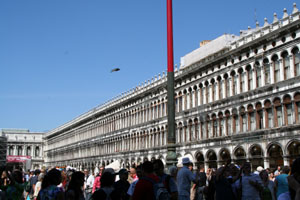
Arcade (Procuratie Vecchie), Piazza San Marco Med Lrg |
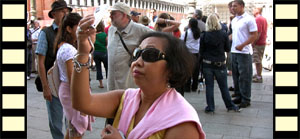
Piazza San Marco MP4-Sml MP4-Med WMV-HD |
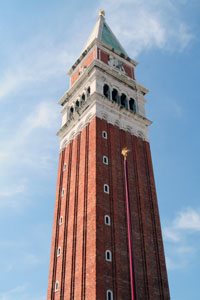
The Campanile Med Lrg |
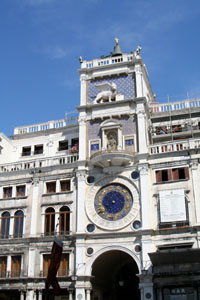
The Clock Tower Med Lrg |

The Basilica Med Lrg |

Basilica Façade Med Lrg |

Mosaic - Saint Mark's Body Venerated by the Doge (1728) Med Lrg |
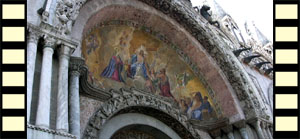
Basilica Façade MP4-Sml MP4-Med WMV-HD |
When the time came for us to enter the Basilica, we presented our reservation confirmation and walked right in. We were a little worried about having to check purses and camera bags, as we’d heard they were pretty strict about taking large bags into the Basilica, but ours were apparently small enough. The interior is on the dark side and amazing. The Basilica is laid out in a Greek Cross configuration (four equal arms) and is surmounted by five domes. And golden mosaics are everywhere. Not far from the entrance, we saw a sign with symbols indicating that a few things weren’t allowed: shorts and sleeveless clothing, photography, and videography. Looking at our fellow visitors, we saw they were obeying the dress code (those who didn’t were denied entry), but that most of them were blatantly taking pictures of one kind or another, including flash, and nobody was telling them not to. Being basically weak individuals, we followed suit. If all of our friends jumped off a cliff, we probably would too. Anyway, here are some of the pictures.

Basilica Interior Med Lrg |
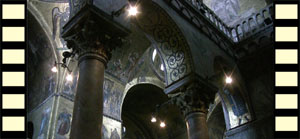
Basilica Interior MP4-Sml MP4-Med WMV-HD |

Pentecost and Ascension Cupolas MP4-Sml MP4-Med WMV-HD |
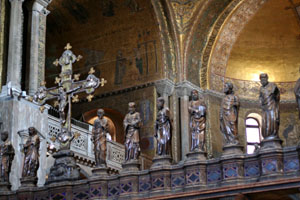
Iconostasis (14th C.) Med Lrg |
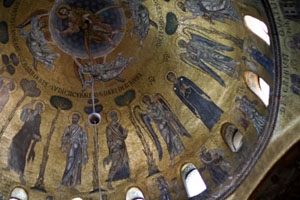
Ascension Cupola Med Lrg |
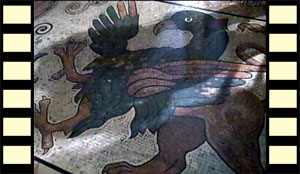
Elaborately Tiled Floor MP4-Sml MP4-Med WMV |
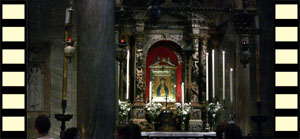
Iconostasis, Cupolas, Mosaics, Madonna Nicopeia Altar MP4-Sml MP4-Med WMV-HD |

The Madonna Nicopeia Altar Med Lrg |

Basilica Interior from Museum MP4-Sml MP4-Med WMV |
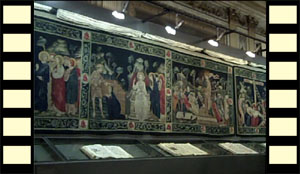
In the Museum MP4-Sml MP4-Med WMV |

Piazza San Marco Med Lrg |
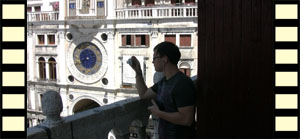
Philip, Clock Tower and Piazza MP4-Sml MP4-Med WMV-HD |

Clock Tower (Upper) Med Lrg |

Clock Tower (Lower) Med Lrg |

The Piazzetta Med Lrg |

The Piazzetta MP4-Sml MP4-Med WMV |
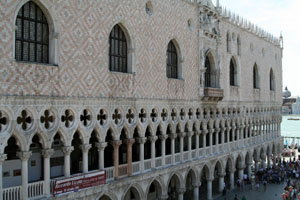
The Doge's Palace Med Lrg |

Porta della Carta, Doge's Palace Med Lrg |

Southern Façade of Basilica Med Lrg |
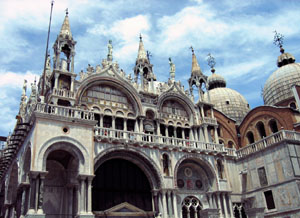
South Façade of Basilica from Piazzetta Med Lrg |
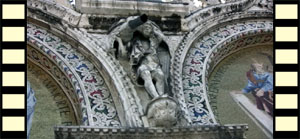
Campanile, Horses and Mosaics MP4-Sml MP4-Med WMV-HD |
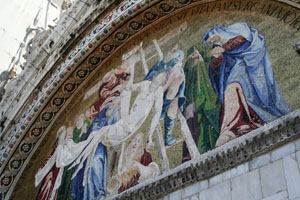
Mosaic - The Deposition (17th C.) Med Lrg |
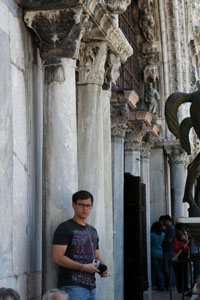
Philip on Balcony Med Lrg |

The Bronze Horses Med Lrg |
Arc de Triomphe du Carrousel, Paris (ca. 2000)
Med
Med
When Napoleon was removed in 1815, so were the horses, and they were returned to their spots on the front of the Basilica, where they have remained ever since. Or sort of, as pollution damage forced them to move indoors in the early 1980’s, for their own protection. The horses on the front of the Basilica now are replicas, but the originals can be seen in the museum. The no-photography rule is actually enforced in the museum, but there may be a video above in which they accidentally appear.
